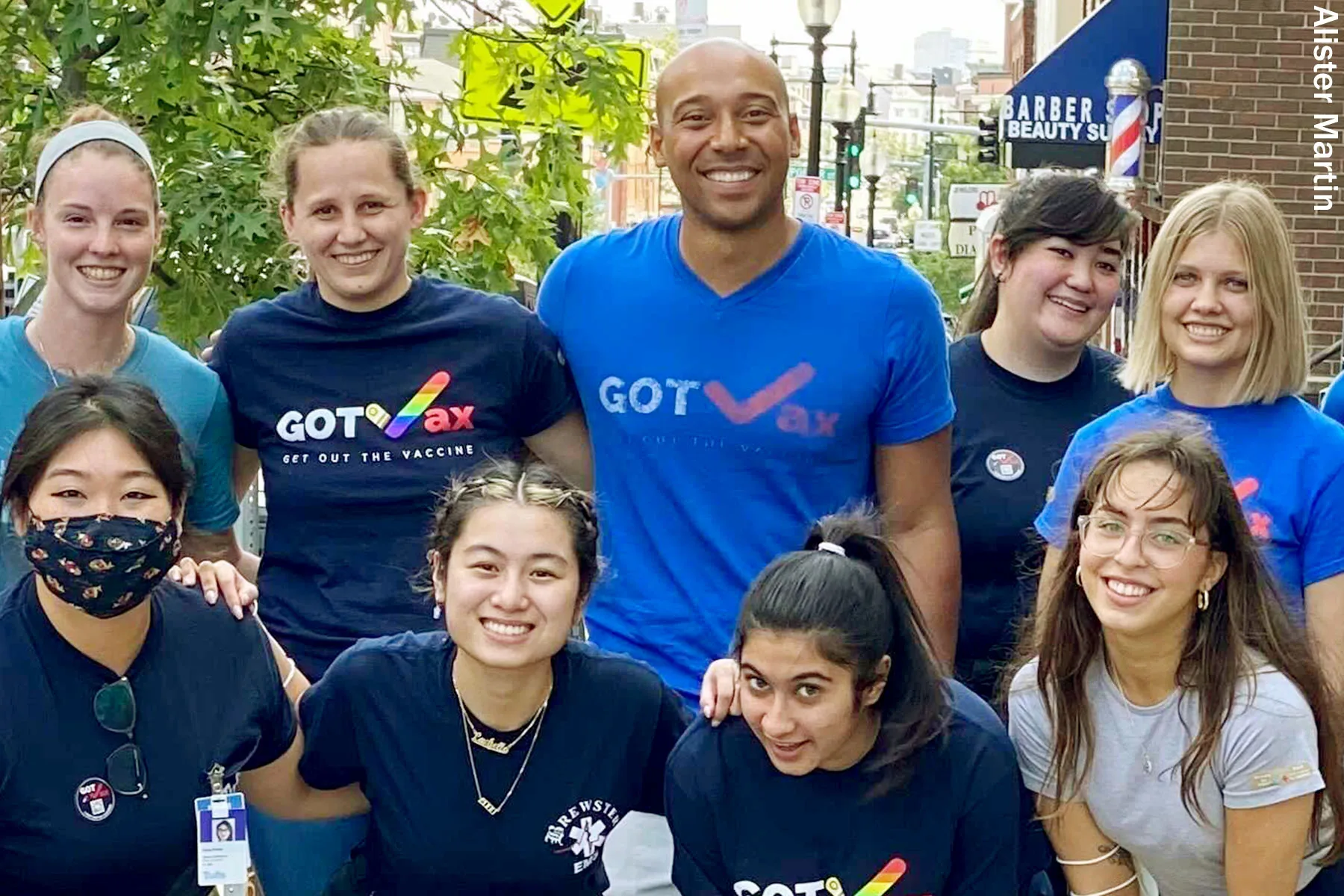How a Case of Mistaken Identity Led to a Life Term for Murder
Thomas Raynard James is serving a life sentence in a Florida prison for a murder he says was committed by someone who happened to have the same name as his. Thirty years later, a GQ journalist found the man who may be the real killer. “The police,” he acknowledged, “were looking for me.”


Thomas Raynard James at Florida’s Okeechobee Correctional Institution, where he’s currently serving a life sentence for murder. Photo by Octavio Jones/courtesy GQ.com
By the time the van arrived to shuttle Thomas Raynard James down to the courthouse, he’d been sitting in jail for three weeks. Long enough for him to consider just how far off-track his life, at 23, had drifted.
He had a notion of what was coming at the hearing. The cops had found marijuana and an illegal gun in his car—he knew he was facing something more serious than the petty drug-possession charges he had dealt with before.
But he was hopeful. He had already come to think of this ordeal as a wake-up call. It was August 1990, and Thomas James had resolved to get his shit together.
James was a hustler, a pot dealer in the projects around Brownsville, north of Miami in central Dade County. He managed a crew and a couple of corners. But in his mind, this was just temporary, a means to an end. He was saving up; he had bigger plans. His goal was to own his own business.
He had saved up about $36,000 so far, which he initially thought wasn’t enough to get started. But recently he’d found a company that worked to help finance small-business plans like his. He let himself imagine big things.
The van slowed to a stop at the courthouse and James shuffled outside, where his hands were cuffed and clipped to a belt; his legs were shackled, and he was chained to about a dozen other inmates. The group was crab-marched into a wood-paneled courtroom and told to sit in the jury box.
Before long, a judge called out their names one by one.
“Thomas James,” the judge read aloud. James stood. But before the judge could detail the charges, the court clerk sitting below the bench reached into a large accordion folder and pulled out a document.
“Your honor,” he recalled the clerk saying, “there’s a warrant out for him for first-degree murder.”
James raised his eyebrows. This was a mistake; he hadn’t murdered anybody. He assumed his file had gotten mixed up with that of one of the other guys on the docket.
The warrant spelled out the particulars: Seven months earlier, near Miami’s Coconut Grove neighborhood, a robbery had gone bad and a man was killed. Hearing all this, James was stunned but not yet scared.
They can’t be talking about me, he thought.
He lived 15 miles from Coconut Grove and had been there only once or twice in his life, and that was years ago. None of this made sense to him.
And yet the defendants’ files hadn’t been mixed up. James’s name really was on the warrant, which said that witnesses had identified him at the scene of the crime.
A public defender James had never met entered a not-guilty plea, and officers whisked James downstairs, where they collected his fingerprints again, snapped a mug shot, and booked him for murder.
EDITOR’S NOTE: what follows is an abridged version of the longer story. The full version can be read here.
[………..]
The murder that James was accused of committing occurred six months earlier, on January 17, 1990. That evening, as dusk was settling over a three-story apartment building at 135 South Dixie Highway, two men approached unit 110, the home of Francis and Ethra McKinnon, an older couple living on disability. One of the men wore a mask; the other didn’t bother.
With the McKinnons that night were Ethra’s daughter, Dorothy Walton, who was a nurse, and her husband, Johnny. …Suddenly, the unlocked apartment door burst wide and a man with a silver handgun rushed in, his face clearly visible. Behind him, a man with what might have been a stocking covering his face followed.
Both shouted for everyone in sight to hit the floor: “Get down! Goddamnit! Get down!”
Dorothy, Johnny, and Ethra did as they were told. Dorothy pleaded, “Please don’t hurt my mother!”
The gunman grabbed the younger woman’s purse off the kitchen table and rifled through it. Francis, hearing the commotion, stepped from the bedroom and into the hallway with a snub-nosed .38-caliber revolver in one hand. He paused to take in the living room’s chaos.
That gave the unmasked intruder just enough time to raise his silver gun and fire. One bullet. It entered Francis’s right cheek, traveled into his neck, and hit the carotid artery. Francis fell where he stood.
[……]
James would later recall that in the weeks that followed, as he prepared for his trial, he met with his lawyer, [Owen Chin], on only three occasions, for less than an hour each time. He knew Chin wanted to present an alibi, but James honestly couldn’t provide one.
“Where were you on January 17?” Chin asked at one point.
“January? It’s August! I don’t know where I was!” James fumed.
Chin ran through the evidence, telling James that prosecutors had a witness who placed him at the scene and even knew his mother. James was perplexed. “My mother? Don’t nobody in Coconut Grove know my mother,” he said.
It was like he was in a parallel universe, one where people were talking about some other Thomas James.
[….]
When Thomas James’s trial began in January 1991, he was still certain that the mix-up would get sorted out. Perhaps naively, he figured that anybody who testified would take one look at him and realize—finally—he wasn’t at the scene that night.
The prosecutor called 11 witnesses; hardly any of them were in a position to recognize James from the crime scene. Most were police officers, crime scene investigators; one was the medical examiner who performed Francis McKinnon’s autopsy.
The trial lasted two and a half days, during which the jury considered four charges: first-degree murder, armed robbery, armed burglary, and aggravated assault. On the third day, when they returned from deliberating, Judge Fredericka G. Smith asked, “Did you reach a verdict?”
With his mother, Doris, watching from the spectators’ bench, James saw the judge take a sheet of paper from the jury foreman.
“We the jury find as follows,” Judge Smith read aloud. “The defendant is guilty of murder in the first degree.”
James went numb. The word guilty followed each of the other charges. He felt unmoored from reality.
A week later, he was given a life sentence. As cold shock spread over him, James realized he had seriously misread the threat to his existence. He would be eligible for parole in 25 years, but that didn’t register. I’m going to die in prison, he thought.
In fact, prosecutors pondered the possibility of the death penalty for James. However, one of them, RoseMarie Antonacci-Pollock, who helped prepare the case, wrote in a memo that she recommended not seeking capital punishment because, as she wrote, “I am extremely concerned about the very weak nature of the state’s evidence in this case.”
[…….]
When Thomas Raynard James shipped off to state prison, he concluded that the only person he could rely on for help was himself. He resolved that if the truth of what happened that night in Coconut Grove was ever going to emerge, he would have to uncover it.
One day, about a year into his sentence, James was walking in the yard at Hendry Correctional Institution, in Immokalee, when another inmate approached him. “You in for that murder in the Grove?” the man asked.
“Yeah, but I didn’t do it.”
The inmate looked James dead in the eye. “I know,” he said. “You and the dude who did it have the same name.”
[………]
When I finally met Thomas James, at South Bay Correctional Facility, a privately run prison on the edge of the Everglades in Palm Beach County, he was no longer the young man who dreamed of owning buildings. He was middle-aged now.
He had wide eyes and a round, friendly face. Years of careful investigation have made him an efficient thinker and communicator. He answered, without hesitation, all of my questions about his growing up, his venturing into the drug trade, and his finding trouble with the law.
He seemed grateful to be heard. “I’ve been trying for a very long time,” he said.
But James didn’t have all the answers to his case. There were limits to what he could uncover. So I spent much of the past year filing public-records requests and searching for documents. I also attempted to track down the people who were at the apartment complex that night, 30 years ago.
[…….]
I was able to interview one of the people present in the complex when McKinnon was killed.
[Cheryl Holcomb, whose mother lived in a neighboring apartment identified the man witnesses said had been seen running from the murder scene as “Thomas James.” She also acknowledged seeing a picture of Thomas Raynard James on the Florida Department of Corrections website. ]’
“See now, the guy they got there, I don’t know him,” she said. “That’s not the Thomas James I know.”
The other Thomas James—who has no middle name and goes by Tommy—is housed these days at the Tomoka Correctional Institution, among the scrub pines of central Florida, just west of downtown Daytona Beach.
When I met him there, he had on a faded blue prison uniform. He was tall, with wide shoulders, and when he sipped from a cup of water, his gold teeth flashed in the light. I could see why he’d been popular with the ladies.
Tommy James has been in jail almost as long as Thomas Raynard James. He was convicted as a habitual offender in 1996, at the age of 23, and given a life sentence, another young man for whom we’d collectively agreed there could be no redemption.
We put him behind bars and lost the key. Maybe that’s why he was talking with me now. He sympathized with the man who shared his name, both buried by society and forgotten.
He wasted no time getting to the point.
“I know the other Thomas James was arrested by accident, by mistake” he told me. “The officers were looking for me.”
The great tragedy of this case is not just that Thomas Raynard James was wrongfully convicted.
That, unfortunately, happens all too often.
The singularity of this tragedy is that he found a way to discover an improbable truth and it wasn’t enough to get anybody’s attention. The criminal justice system, that vast assemblage of state agencies and bureaucracies, is not designed to look backward.
It is a juggernaut that rolls unceasingly forward.
ED NOTE: As of this writing, Thomas Raynard James remains behind bars.
Tristram Korten, author of ‘Into the Storm: Two Ships, a Deadly Hurricane, and an Epic Battle for Survival,’ is a 2020 John Jay Justice Reporting Fellow. The full article on which this excerpt is based appeared in the August 2021 issue of GQ under the title “The Tragic Case of The Wrong Thomas James,” and can be accessed here.

 Landwebs
Landwebs 





















